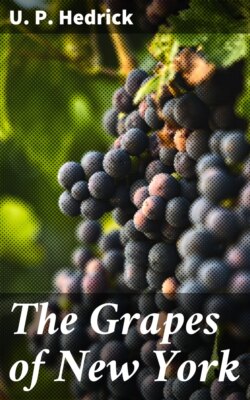Читать книгу The Grapes of New York - U. P. Hedrick - Страница 46
На сайте Литреса книга снята с продажи.
17. VITIS DOANIANA Munson.
ОглавлениеTable of Contents
1. An. Hort., 1889:101. 2. Munson, U. S. D. A. Pom. Bul., 3:9. 1890. 3. Ib., Gar. and For., 3:474. 1890. 4. Ib., Mich. Hort. Soc. Rpt., 1893:116. Doan’s grape. 5. Ib., Bush. Cat., 1894:20, 22, 24. Doan’s grape. 6. Sears, Gar. and For., 9:454. 1896. 7. Bailey, Gray’s Syn. Fl., 1:427. 1897. 8. Beach, N. Y. Sta. An. Rpt., 17:536, 557. 1898. 9. Munson, Tex. Sta. Bul., 56:232, 234, 235, 240, 268. 1900. fig. Texas Panhandle Large Grape. 10. Viala and Ravaz, Am. Vines, 1903:154.
Vine vigorous, climbing or shrubby if left without support; wood on mature canes cylindrical or slightly angled; diaphragm thin; tendrils intermittent, bifid, rather weak. Leaves medium in size, broadly cordate, notched or lobed and with a triangular apex; petiolar sinus medium in depth, usually narrow; margins with rather large, notched-like teeth; upper surface of a peculiar bluish-green, frequently somewhat rugose with more or less tomentum; lower surface usually with a dense whitish pubescence which shows also on shoots. Cluster medium to small. Berries variable in size, average medium, black with a thick bloom. Seeds somewhat resembling Labrusca but with shorter beak and more distinct chalaza; has characteristic groove extending from chalaza to beak.
Doaniana is quite variable, some specimens being nearly glabrous at maturity while others are densely covered with white pubescence. Munson has separated the species into two forms which he calls the early Doaniana and the late Doaniana. The species was described and named by Munson in 1890.
It is found chiefly in northwest Texas but it ranges from Oklahoma to beyond the Pecos River in New Mexico. It is considered by Bailey and Viala to be a probable hybrid with Vitis candicans as one of the parents. Doaniana is exceedingly hardy, withstanding great cold as well as great heat. It apparently prefers rather light soils as it is indigenous to sandbanks along rivers and the beds of sandy ravines.
Munson states that in cultivation it does well in any but very limy soils. The fruit is of comparatively good quality but the skin possesses some of the pungency of Candicans. The berries are quite persistent, hanging to the pedicel some time after ripe. The vines are not productive. The character of the must is apparently unknown. The roots are hard, penetrate deeply into the soil, and are resistant to phylloxera though somewhat variable in this respect. Doaniana grows readily from cuttings and grafts well in the vineyard. The species blossoms with or just before Labrusca. It is of doubtful value to the southern grape-growers and is of no value in the North.
